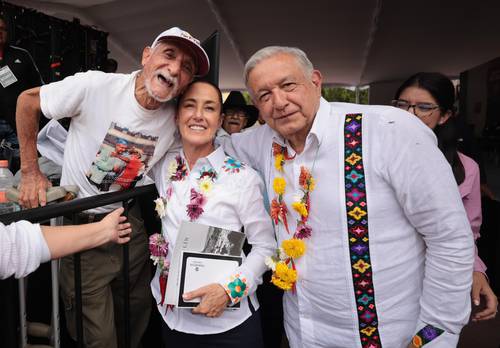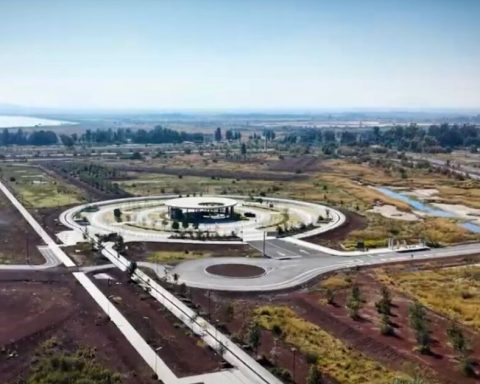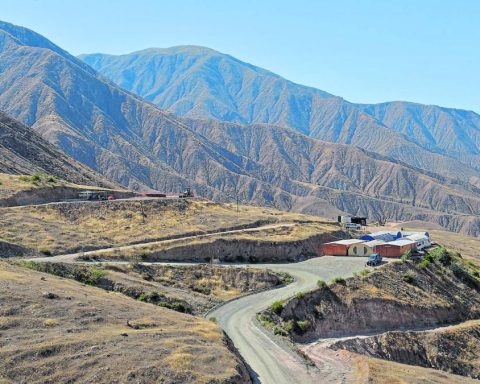▲ On the tour with López Obrador, Sheinbaum recognized the struggle of Temacapulín, Acasico and Palmarejo against the assault: this demonstrates, she said, the validity of the principle with the people everything and without the people nothing
.Photo The Day
Alonso Urrutia
Sent
The newspaper La Jornada
Sunday, August 18, 2024, p. 5
Temacapulín, Jal., Thank you for not flooding Temacapulín, Mr. President!
read the legend that some infants were waving on banners addressed to Andrés Manuel López Obrador. A simple phrase that summed up the gratitude that he gave them for the survival of this town and others in the Altos de Jalisco, which the old Fox project intended to disappear under water with the construction of the El Zapotillo dam.
Sentenced to disappear by the neoliberal pragmatism of the time, Temacapulín, Acasico and Palmarejo waged a long struggle to preserve their towns from the Foxist onslaught, which had decreed flooding them to guarantee the water supply to Guanajuato and Guadalajara.
A project that would sink their communities into the waters, along with the historic Basilica of the Virgin of Los Remedios, so miraculous, they say, for the locals. A viceregal temple was going to succumb despite its 300 years of history.
Only with the arrival of the Obrador government to power was the neoliberal spell that had doomed these communities lifted. This Saturday, accompanied by the president-elect, Claudia Sheinbaum, and the state governor, Enrique Alfaro, López Obrador led the final evaluation of the comprehensive program to repair the damage to these communities, a rebirth of this region.
An official act that for the residents was the celebration of having managed to recover their communities. Sheinbaum recognized the balance of the struggle of these towns to defend themselves from centralist domination: this demonstrates, she said, the validity and application of the principle of the movement, with the people everything and without the people nothing
.
Temacapulín, converted into a magical town
Recently, the program that includes 15 urban and educational actions, which were implemented in agreement with the communities, allowed, said Claudia Gómez, leader of the rescue program, to turn Temacapulín into a Magical Town.
Even in the midst of the political effervescence that dominated the event among the attendees, a consequence of the post-election struggle, López Obrador thanked the collaboration of the people whose resistance managed to stop the excesses of the original project.
Thank you for all your support, because you did not act in an intransigent manner, there was no narrow-mindedness in defending a very just cause, since it was the disappearance of these three towns. Their temples, their dead, all the cultural tradition of these towns and despite that, even though their cause was so just, they did not completely overthrow the project.
the president said.
He recalled that billions of pesos had already been invested in a strategic water project for Guadalajara and its metropolitan area. It would have meant a failure to abandon this project. They acted with great fraternity because water is needed for Guadalajara. Everything was achieved: the villages were not flooded and a technical solution was found.
to continue with the project, he added.
Mutual recognition
After overcoming the shouting match between Morena and MC supporters that preceded the event, who brought their dispute over the governorship to the official event, Enrique Alfaro outlined the scope of the construction and adaptation of the El Zapotillo dam, after 20 years of failures since Vicente Fox conceived it. A fundamental work to address the water shortage in Guadalajara.
“Today we were able to reconcile the two positions. We achieved a historic project: we have resolved the water supply for the city for the next 50 years and laid the cornerstone for comprehensive water management, because the El Zapotillo dam is part of a system of dams to take advantage of the water from the Verde River (…). Therefore, President, beyond the grid, I am very proud to have worked with you,” said Alfaro.
A compliment that López Obrador returned by praising the state government’s collaboration in achieving a compromise between starting up the El Zapotillo dam and preserving these localities.
The head of the National Water Commission, Germán Martínez, highlighted the water balance of this reconciliation between the technical aspects and the needs of these towns: 3 thousand liters per second will be transferred through the El Zapotillo-El Salto aqueduct to the metropolitan area of Guadalajara, which will benefit 1.2 million people, with an investment of 8.9 billion pesos in the entire system that was launched, which includes the El Zapotillo dam.
The community of Temacapulín is beyond the numbers. Armando Alvarado, who is already getting on in years and knows a lot about the history of the town, is going to adjust
65 years old, he is not entirely convinced about the effects of this program: “They say that the town is supposedly magical now…”
The Mexican Institute for Community Development (IMDEC), which together with the Lawyers’ Collective was a fundamental part in avoiding the displacement of the residents of Temacapulín, Acasico and Palmarejo, in the Jalisco Highlands, due to the construction of the El Zapotillo dam, recalled that many issues still need to be resolved in order to do justice to almost 16 years of uncertainty that citizens experienced under the threat of flooding.
In the framework of the inauguration of the El Zapotillo dam this Saturday, the IMDEC issued a statement in which it asks to record the historical fact that Governor Enrique Alfaro – who was booed during the event in the Temacapulín square – was in favor of flooding the communities, sending water from the dam to Guanajuato and opposed the technical proposal of the towns so that the dam would not be a risk in case the Verde River filled with water.
(With information from Juan Carlos G. Partida, correspondent)















